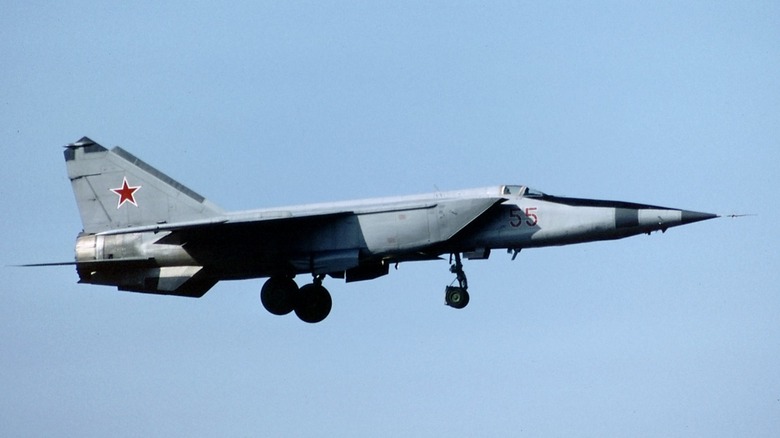This Historical Defection Forced Russia To Upgrade Its Old School MiG-25 To The MiG-31
The Cold War was one of the most dangerous periods of recent world history. The United States, the Soviets, and the wider world around them can thank their lucky stars that it didn't escalate into a full-blown conflict. Part of the reason why it didn't was that neither side knew what the other was capable of. Let's take the MiG-25: this speedster aircraft in the Soviet arsenal was widely feared by the United States, with Soldier Of Fortune Magazine quoting then-Secretary of the Air Force, Robert Seamans, as declaring it to be "probably the best interceptor in production in the world today."
The most notable aspect of this statement, however, would surely be the "probably." The fact is that both sides of the Cold War jealously guarded their secrets and wanted to keep the capabilities of their military tech secret. The only realistic way to learn what the mysterious yet terrifying MiG-25 jet can really do was to procure one to investigate. It was a stroke of tremendous fortune that one Soviet pilot, Viktor Belenko, had decided to defect to the U.S. "Soviet propaganda at that time portrayed you as a spoiled rotten society which has fallen apart ... but I had questions in my mind," he would tell Full Context magazine two decades later, according to the BBC. Belenko did not simply bring the United States information about the MiG-25, he brought the aircraft itself, having flown one all the way to Japan during his bid for freedom. For the Soviet Union, this meant two inevitable truths: The United States had a treasure trove of information on its hands, and the MiG-25 would need to be upgraded in short order. Thus, Belenko's defection directly resulted in the Soviets' hurried technological leap from the MiG-25 to the MiG-31.
How Viktor Belenko's daring defection took place
In 1976, Belenko, Soviet first lieutenant, saw better opportunities for himself in the United States, believing that the Soviet Union system was denying him the freedom he craved. John Barron's "MiG Pilot: The Final Escape of Lieutenant Belenko" also noted that the pilot's wife "had adamantly demanded a divorce and had announced her intent to take their child back to her parents," all of which underscored the fact that Belenko could no longer see a future for himself in the Soviet Union.
Based at the Chuguyevska Air Base at the time, Belenko seized a chance during a training exercise. He simply left the formation of MiG-25s (another model of which is pictured here) that he was flying in and began a flight away from the Soviet Union. His ultimate goal was America, but the aircraft wouldn't have made it that far afield. Instead, he flew for Japan, eventually touching down at Hakodate Airport. Using his radar knowledge as a Soviet pilot, Belenko was able to both avoid being detected by his former compatriots and ensure that the Japanese systems could only detect him when he was sufficiently safe for them to do so. Though he did come to land safely, the runway at the airport he ultimately opted for wasn't as long as he was expecting, and so landing itself was more of an event than he had bargained for. Barron wrote, Soldier of Fortune Magazine reports, "Tires burning, [the plane] screeched and skidded down the runway, slowing but not stopping. It ran off the north end of the field, knocked down a pole, plowed over a second and finally stopped a few feet from a large antenna 800 feet off the runway. The front tire had blown, but that was all."
The rise of the MiG-31
Belenko was held in custody. Japan's situation was then, in effect, between the two superpowers, as the pilot wished for asylum in the United States and the Soviet Union was desperate for his return, fearing the military secrets that he and his plane could provide. He would be granted asylum that October, and ultimately made a full U.S. citizen under President Carter. After a career with the U.S. Air Force (changing his name to Viktor Schmidt during the height of tensions), he passed away in 2023. The MiG-25 was the first that the U.S. had been able to study. A close examination of every little piece of the aircraft, after its transportation to an airbase, revealed that it wasn't an unstoppable aircraft capable of achieving air dominance over the United States, though it had scared America into creating the F-15. It was designed as an interceptor, capable of Mach 2.8 (with a faster recon model that was capable of Mach 3.2), but sacrificing control for that pure power. It also had unwieldy engines that consumed huge amounts of fuel, as well as old school weighty vacuum tubes that made its radar less effective than its U.S. counterparts.
The MiG-25 was delivered back to the Soviet Union by the Japanese government. The development of the MiG-31, which had begun the previous year, was accelerated as a result of this event. The Mikoyan-Gurevich MiG-31, referred to by NATO as Foxhound, featured more effective D-30-F6 engines and increased fuel capacity for better range, as well as sophisticated radar and instruments. Flightglobal's Stephen Trimble described the model to the BBC as "essentially a full realization of what the MiG-25 was supposed to be." The significant differences between the MiG-25 and MiG-31 were, in part, a result of the defection.


